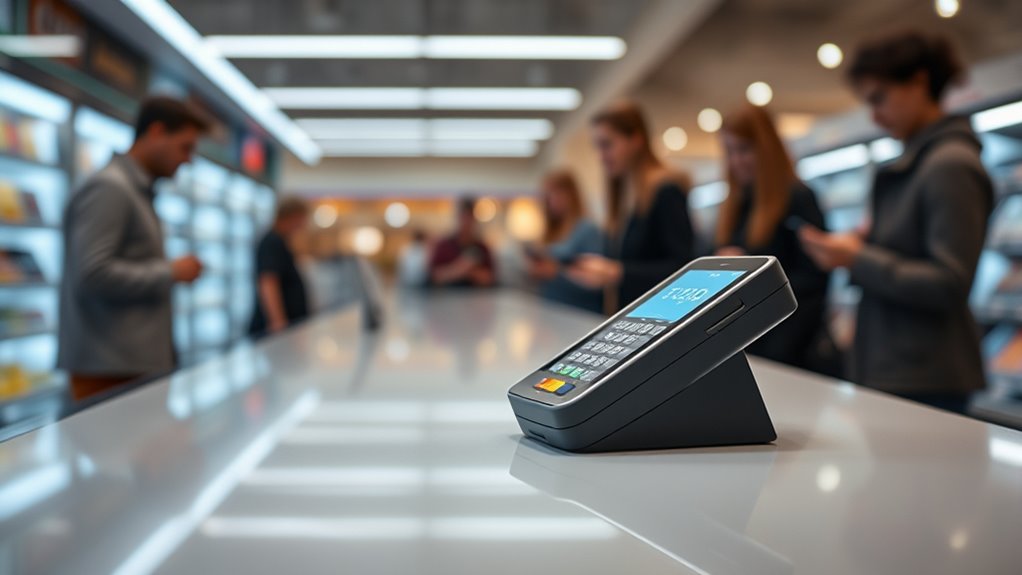As digital payments grow, cash is still essential for many in the US. It offers immediacy, privacy, and trust, especially for older adults and rural communities. Though more people prefer digital wallets and contactless options, cash remains a fallback and safety net. Its role is shrinking but still critical for inclusivity and small businesses. To understand how this ongoing shift impacts you and the economy, explore what’s behind these changes and what’s next.
Key Takeaways
- Digital wallets and contactless payments are rapidly replacing cash in retail and online transactions in the US.
- Cash remains vital for rural, lower-income, and older populations due to trust and accessibility.
- The decline of cash indicates a shift toward a more digital, efficient, but potentially exclusionary financial ecosystem.
- Regional disparities persist, with urban areas adopting digital payments faster than rural communities.
- Recognizing cash’s ongoing role highlights the need for inclusive financial infrastructure amidst technological progress.

Have you ever wondered why cash payments still hold a significant place in the US economy? Despite the rapid rise of digital payment methods, cash remains a common choice for many Americans. This persistence can be partly explained by the way digital wallets and banking shifts are transforming how we handle money. Digital wallets, like Apple Pay or Google Pay, offer convenience and security, yet millions of people still prefer cash for everyday transactions. The reason is simple: cash provides immediate, tangible proof of payment, and many trust it over newer, less familiar options. Plus, cash doesn’t require a smartphone or internet connection, making it accessible regardless of technology or location.
At the same time, banking shifts have played a crucial role in shaping this landscape. Traditional brick-and-mortar banks are increasingly supplementing their services with digital banking platforms, making financial transactions more seamless. However, not everyone has fully embraced these shifts. Some populations, especially older adults or those in rural areas, might feel more comfortable sticking with cash. They see it as straightforward, private, and less susceptible to technical glitches or cyber threats. For these groups, cash remains a reliable fallback amid the evolving banking environment.
The growth of digital wallets and online banking has also accelerated the decline of cash in many sectors, especially retail and online shopping. Contactless payments are faster and often more hygienic, encouraging consumers to leave cash at home. Still, cash continues to be vital for small businesses, street vendors, and in situations where digital infrastructure is lacking or unreliable. For many, cash is a safety net, a backup when electronic payments fail or when privacy is a concern.
Furthermore, the shift toward digital payments is not uniform across the country. Urban areas with high-tech infrastructure see more widespread adoption of digital wallets and banking shifts, while rural communities and lower-income households tend to rely more on cash. This discrepancy highlights that despite technological advances, cash remains an essential part of the financial ecosystem. It’s a tool that offers control and simplicity, especially for those who may feel overwhelmed by digital options or distrust online security measures.
In essence, even as digital wallets and banking shifts reshape the way we pay, cash endures because it is accessible, tangible, and trusted. Its role may diminish over time, but for now, cash still plays a crucial part in ensuring everyone can participate in the economy—regardless of technological proficiency or access. Understanding the continued importance of cash helps clarify how the financial landscape remains diverse and inclusive.
Frequently Asked Questions
How Do Small Businesses Handle Digital Payment Processing Costs?
You handle digital payment processing costs by choosing mobile wallets and contactless payments that often offer lower fees or flat-rate structures. You may also negotiate better terms with providers or encourage customers to use specific platforms to reduce expenses. Additionally, you might absorb some costs to attract more customers or pass them on subtly through pricing strategies, ensuring your small business stays competitive while embracing the convenience of digital payments.
What Are the Security Concerns With Digital Payments?
Imagine digital payments as a secure vault, but vulnerabilities exist. You might worry about fraud, hacking, or data breaches. Biometric authentication adds a layer of security, yet risks remain if systems aren’t well-protected. Cryptocurrency regulation is evolving, but unregulated exchanges can be targets. Staying vigilant, using strong passwords, and trusting reputable providers help protect your transactions and personal info from cyber threats.
How Does Cashless Payment Adoption Affect Rural Communities?
You might find that cashless payment adoption challenges rural communities due to limited rural infrastructure and lower digital literacy. Without reliable internet or devices, accessing digital payments becomes tough, potentially excluding those who rely on cash. This shift can widen existing gaps, making it harder for residents to participate fully in the economy. To bridge this, investments in rural infrastructure and digital literacy programs are essential, ensuring everyone benefits from digital financial services.
Are There Legal Protections for Digital Payment Fraud?
Yes, there are legal safeguards in place to protect you from digital payment fraud. These laws require financial institutions to implement fraud prevention measures and promptly investigate suspicious activity. If you experience fraud, you can often dispute unauthorized charges and seek reimbursements. Always stay vigilant and report any suspicious transactions quickly, so the legal protections work effectively to safeguard your money and personal information.
How Do Digital Payments Impact Financial Inclusion?
Digital payments open the door to financial inclusion like a bridge over turbulent waters. You find that cryptocurrency adoption and mobile banking accessibility allow more people to access banking services, even in remote areas. This technology reduces barriers, making transactions easier and safer. As you embrace digital payments, you help expand financial opportunities for everyone, turning the digital landscape into a level playing field where more can participate and thrive in the economy.
Conclusion
As you see, cash payments in the US have dropped considerably, with only about 19% of transactions now happening in cash. This shift reflects how digital payments are replacing traditional methods, making transactions faster and more convenient. It’s fascinating to think that just a decade ago, cash was king, but now, over 80% of transactions are cashless. Embracing these changes can help you stay ahead in an evolving financial landscape.









